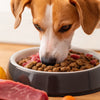What Dog Kibble is Best: A Comprehensive Guide for Pet Owners
- Houndsy
Table of Contents
- Introduction
- Understanding Your Dog's Nutritional Needs
- Key Ingredients in Quality Dog Kibble
- Decoding Dog Food Labels
- Top Dog Kibble Brands to Consider
- The Importance of Feeding Routines
- Conclusion
- Frequently Asked Questions (FAQs)
Introduction
Did you know that over 70% of pet owners believe that their dog's diet significantly impacts their health and happiness? As dog lovers ourselves, we understand that choosing the best kibble for our furry companions can feel overwhelming with the vast array of options available. The market is filled with products boasting various benefits, but how do we determine what dog kibble is best for our individual pets?
In this blog post, we will delve deep into the world of dog kibble, exploring the factors that make a kibble truly exceptional. Our aim is to help you make informed decisions that enhance your dog's well-being while simplifying your feeding routine. By the end of this article, you'll have a comprehensive understanding of what to look for in dog food, the importance of quality ingredients, and how our flagship product, the Houndsy Kibble Dispenser, can elevate your dog-feeding experience.
We will cover the following key points:
- The nutritional needs of dogs and how they vary by age, breed, and health condition.
- Essential ingredients to look for (and avoid) in dog kibble.
- How to read and understand dog food labels.
- Recommendations for high-quality dog kibble brands.
- The role of feeding routines in your dog’s health and happiness.
- How the Houndsy Kibble Dispenser enhances the feeding experience.
So, let's embark on this journey to discover what dog kibble is best for our beloved pets!
Understanding Your Dog's Nutritional Needs
Life Stages and Dietary Requirements
Just like humans, dogs have different nutritional needs at various stages of their lives. Puppies require special formulations to support their rapid growth and development, while adult dogs benefit from a balanced diet that maintains their health. Senior dogs often need diets that are easier to digest and fortified with nutrients that support aging joints and cognitive functions.
- Puppies: High in protein and fat to support growth.
- Adults: Balanced nutrients for maintenance.
- Seniors: Easier digestion and joint support.
Breed Size Considerations
The size of your dog also plays a crucial role in determining their dietary needs. Smaller breeds may require higher calorie density in their kibble due to their fast metabolism, while larger breeds often need lower-calorie options to avoid obesity.
- Small Breeds: Higher protein and calorie content.
- Large Breeds: Controlled fat levels and joint-supportive ingredients.
Health Considerations
If your dog has specific health conditions like allergies, sensitive stomachs, or obesity, it’s essential to choose kibble that addresses these needs. For instance, limited ingredient diets are great for dogs with food sensitivities, while weight management formulas can help overweight pets shed pounds.
Key Ingredients in Quality Dog Kibble
Protein Sources
The primary ingredient in dog kibble should ideally be a named animal protein, such as chicken, beef, or fish. This ensures your dog gets high-quality, digestible protein that supports muscle maintenance and overall health.
Avoid: Kibbles that list vague terms like "meat meal" or "animal by-products," which can be lower in quality and nutritional value.
Grains vs. Grain-Free
The debate over grains in dog food continues, with some advocating for grain-free diets while others emphasize the benefits of whole grains. It’s essential to consider your dog’s specific dietary needs when choosing between these options.
- Grains (e.g., brown rice, oats): Provide energy and fiber.
- Grain-Free: Suitable for dogs with grain allergies, but ensure there are alternative carbohydrate sources.
Fillers and Additives
Avoid kibbles that contain fillers like corn, soy, or artificial preservatives, colors, and flavors. These ingredients offer little nutritional value and can lead to health issues over time. Instead, look for kibbles that use whole, recognizable ingredients.
Fat Content
Healthy fats, such as omega-3 and omega-6 fatty acids, are essential for skin and coat health, as well as overall energy. However, the fat content should be appropriate for your dog's age and activity level.
Decoding Dog Food Labels
Understanding dog food labels can be daunting, but it’s crucial for making informed choices. Here are key components to consider:
- AAFCO Statement: Look for a statement from the Association of American Feed Control Officials, indicating that the food meets nutritional standards.
- Guaranteed Analysis: This section breaks down the percentage of protein, fat, fiber, and moisture in the kibble.
- Ingredient List: Ingredients are listed in descending order by weight, so the first few should be high-quality protein sources.
Top Dog Kibble Brands to Consider
After evaluating several brands, we’ve identified a few that stand out for their quality ingredients and nutritional profiles:
- Open Farm: Known for its sustainable sourcing and high-quality proteins, Open Farm offers a range of options suitable for various dietary needs.
- Merrick: Offers grain-free and limited ingredient diets that prioritize high-quality meat sources.
- Taste of the Wild: Provides diverse protein sources and is known for its affordability without compromising on quality.
- Wellness: Focuses on natural ingredients and offers specialized formulas for different life stages.
- Houndsy Kibble Dispenser: Not only does it store kibble, but it also allows for precise portion control, ensuring your dog gets the right amount every time.
For a deeper look at our hero product, the Houndsy Kibble Dispenser, click here.
The Importance of Feeding Routines
Creating a Consistent Feeding Schedule
Establishing a regular feeding routine is beneficial for both you and your dog. It helps regulate their digestion and can prevent overeating. Dogs thrive on consistency, and knowing when to expect meals can alleviate anxiety around feeding times.
Portion Control
Using a product like the Houndsy Kibble Dispenser can significantly aid in portion control. This innovative dispenser allows you to serve perfect portions at a standing height, eliminating the need for bending and mess. Its auto-locking mechanism prevents accidental dispensing, making it a reliable choice for busy pet owners.
Conclusion
Choosing the right dog kibble is an essential part of ensuring our furry friends lead happy, healthy lives. By understanding their nutritional needs, deciphering ingredient labels, and establishing consistent feeding routines, we can make informed decisions that benefit our pets' well-being.
As you continue your journey to find the best dog kibble, remember that our flagship product, the Houndsy Kibble Dispenser, not only simplifies your feeding routine but also enhances your dog-feeding experience. With its mid-century modern design and ergonomic convenience, it’s an investment in both functionality and style.
If you want to elevate your dog’s feeding experience and ensure they receive the perfect portions every time, explore the Houndsy Kibble Dispenser today!
Frequently Asked Questions (FAQs)
What should I look for in dog kibble?
Look for high-quality animal protein sources, a good balance of fats, and minimal fillers or artificial additives. Always check for an AAFCO statement to ensure nutritional adequacy.
Can I feed my dog grain-free kibble?
Yes, grain-free kibble can be suitable for dogs with grain allergies. However, ensure that alternative carbohydrate sources are included in the formula.
How much kibble should I feed my dog?
Portion sizes depend on your dog’s age, size, and activity level. Consult your veterinarian and follow the feeding guidelines provided on the kibble packaging.
Is wet food better than dry food?
Both wet and dry foods have their pros and cons. Dry food is more convenient and can help with dental health, while wet food often has higher moisture content and can be more palatable for picky eaters.
How can the Houndsy Kibble Dispenser improve my feeding routine?
The Houndsy Kibble Dispenser allows for precise portion control, reduces mess, and adds an element of style to your home. With its innovative design, it makes feeding time easier and more enjoyable.
We hope this comprehensive guide has empowered you to make informed choices about what dog kibble is best for your beloved pet. Let’s make mealtime a delightful experience for both you and your furry friend!












